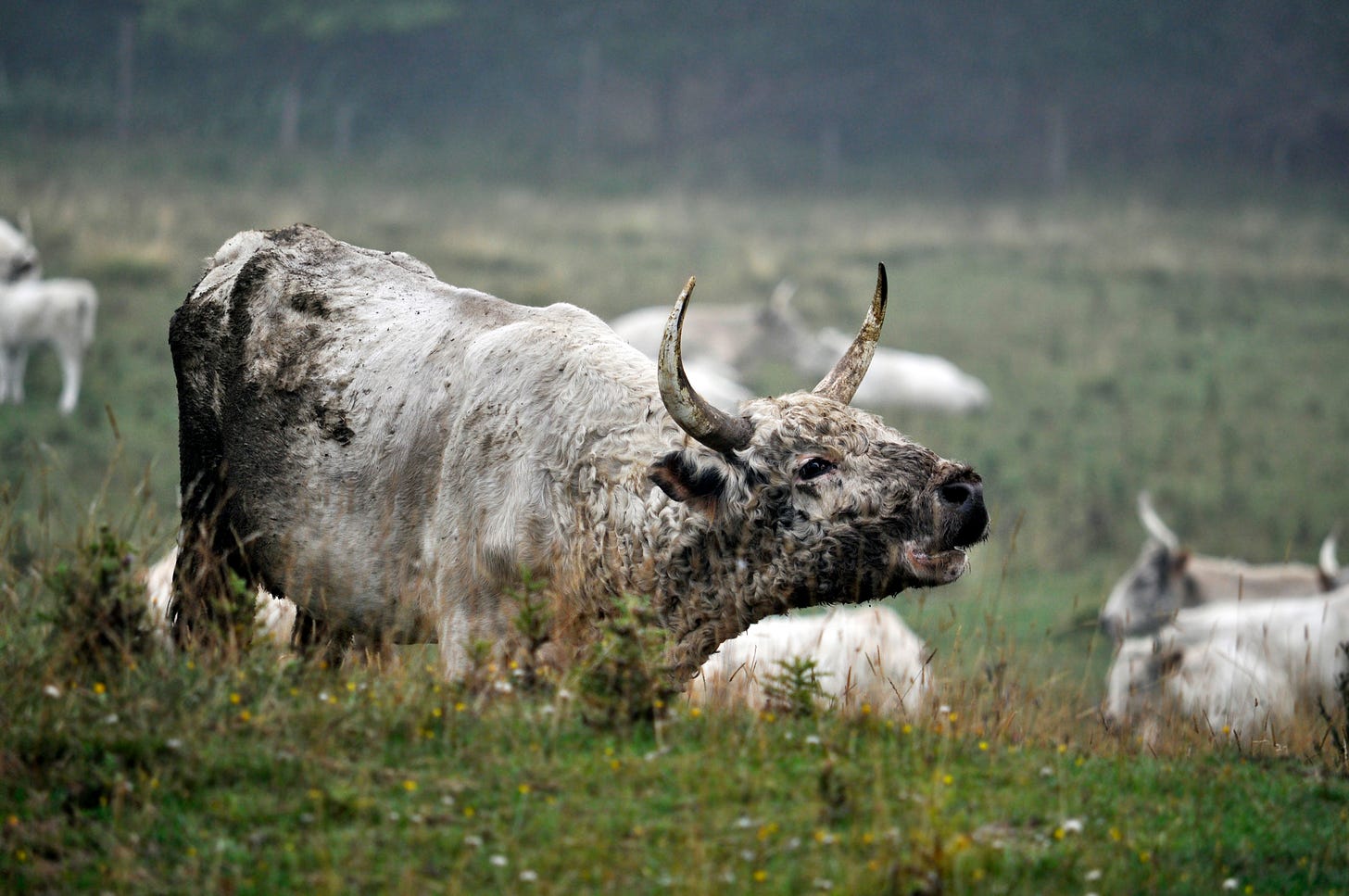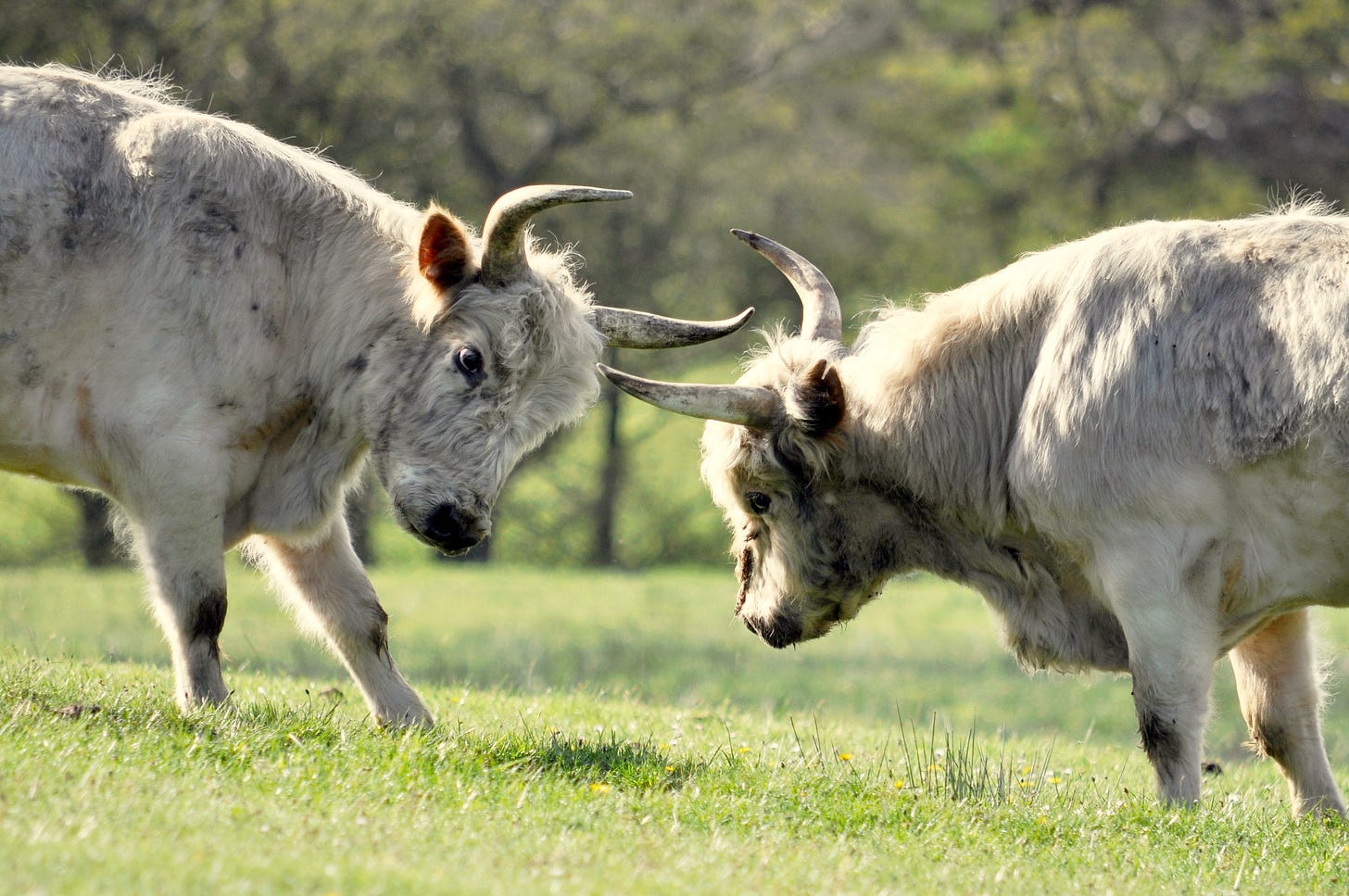‘You must go and see the ancient wild cattle at Chillingham!’ Emma enthused once I announced I’d be stopping in Northumberland, near to Bamburgh Castle – a heritage spot I’d been keen to see for some time, any fans of The Last Kingdom will know why, ‘Destiny is all!’
Since my first visit to New Zealand, my appreciation of, and intrigue for the natural world has been ignited. I was intrigued at the mere mention of ancient wild cattle, and so I decided to book onto a tour to find out more. I narrowly missed the tour, arriving minutes late (so be prompt if you visit) but kindly got driven up to meet the group by one of the trustees.
This formidable herd of cattle roam freely within the 300 plus acre park overlooking the rolling Cheviot Hills and have existed here for up to 700 years!
These cattle are unlike any of the 800 breeds of commercial cattle and are survivors of their ancient ancestors who once freely roamed Britain’s forests and parkland, both in their behaviours, characteristics but most interestingly genetically. Their genome is not closely related to any other breed of cattle to date. They are in fact rarer than mountain gorillas or pandas.

Perhaps their most starkly unique characteristic is their eerily white coat yet endearing mottled faces. Their grande, curved horns are both intimidating and mesmerising, giving off an air of nobility much like a stag’s impressive antlers. There is something truly captivating about these creatures.
They are shorter, stocky animals, with the majority of their weight in their shoulders, rather than at the back which is typically seen in beef cattle, this front heavy characteristic is resemblant of medieval cattle, we learn from our guide.
Shortly after we entered the park, one of the herd’s bulls began a deep lowing, communicating to other nearby bulls. What followed was an expressive display of stamping, lowing, and mud pawing creating a cloud of dust between them. The knowledge of the warden was incredible, their ability to read their behaviour and feed back to us was inspiring.
The cattle are not handled by anyone, and receive no veterinary treatment, though seem unphased by us mere observers. I imagine they’d roll their eyes if they could, with an unenthused look, ‘here comes the third group of tourists today Beryl,’ Clover says to sister Beryl, who lets out an uninterested yawn, before taking a mouthful of lush grass, paying no heed to us as we look on in awe.
Despite the number of bulls, I was surprised to hear that they will choose to avoid conflict given the chance. I wonder if this is due to their freedom and acreage to roam which is a stark contrast to many of our commercial herds and how bulls are managed within these?
At the time of my visit, in October, there are 119 head of cattle, split into two main herds, with further dispersed Bachelor herds comprised of retired and kicked out young bulls. Often these younger bulls will spend time away from the main herds, growing and maturing before coming back down to challenge at a later date.
Interestingly, females are born and die in the herd they’re born into. During calving, it is always single calves born, with 23 new additions this year. Noticeably, none of the animals wear ear tags and are allowed to live as naturally as possible, encouraging them to exhibit as many of their natural behaviours as possible. The cattle, whilst ‘wild’ are owned and managed by The Chillingham Wild Cattle Association, ‘a registered charity, founded in 1939 to maintain Chillingham Park and to keep its unique wild cattle safe for future generations.’
An incredibly harsh winter in 1947, with relenting snow, freezing temperatures and weather akin to that life north of The Wall in Game of Thrones, caused these incredible creatures to come close to being wiped out. Dozens of cattle perished due to the unforgiving elements, leaving only 5 bulls and 8 cows remaining.
The Chillingham Wild Cattle have been traced here at the park, as far back as 1642, with a letter found at the neighbouring castle referencing, ‘My Lord’s wild beasts…’
The park itself is captivating in it’s own right. It’s picturesque, almost a picture perfect example of our British countryside. With rolling hills, vibrant green grass underfoot (though it was a misty, damp morning it was still breathtaking), ancient trees and natural winding waterways carving their desired path through the landscape.
The cattle receive no wormers and rely on the natural ecosystem and biodiversity within the park including a ‘self-fertilising’ system when it comes to grass and forage regeneration. I learnt a lot about mushroom decomposition and their underground systems! It truly was fascinating.
Despite the cattle receiving no human handling, there are two things that the organisation are legally obliged to provide. The first is to put hay down over the winter months, due to the cattle not being able to migrate. Though this is calculated and kept to an absolute minimum. The second, is to end an animal’s suffering on welfare grounds only. Our tour guide and park warden was keen to highlight that, “if we start to decide who lives and who doesn’t then natural order changes.”
The deceased cattle are buried onsite, trying to keep the cycle of life as natural as possible. A post mortem is carried out for research purposes, to enable the park to learn as much as possible about the cattle so that they are able to support their preservation here at the park. Liver fluke (Fasciola hepatica) is commonly seen, and is a bacteria found living in the liver and bile ducts of cattle, carried by it’s host, a mud snail.
These scientific marvels are extensively inbred, with a 92% similarity! To put that into context, commercial cattle display around an 18% mark. ‘How they are still here without three eyes and six legs is a mystery,’ our tour guide jokes, though there is some seriousness in the jibe. It is suspected that the cattle have purged out bad genetics, and that they’ve evolved to what works for their landscape, which has remained fairly consistent over the centuries.
How these cattle curiously came to be here many hundreds of years ago is still unclear, and just how they continue to survive and thrive here also remains much of a mystery too, though it is a delight and a real treat to experience in person. Nature truly is wonderful.

Image credit for the two photographs in this article, Rick Waddington.
Whilst I wish, like many who’ve visited, I am sure, that I could get up close and personal with these phenomenal creatures, they are majestic in their own mysterious and somewhat forbidden right. You can look but you can’t touch. There is a back up plan up in Scotland, in the devastating case of a herd wipe out with an embryo project, however it goes without saying that the connection between these animals, and this place would be lost. The Chillingham Wild Cattle really are an embodiment of living history and it was a real privilege to learn about and see them interacting in their ancient home. Oh the stories these trees and hills would tell if they could…
If you’re planning a visit to Northumberland to experience these magical creatures, then I cannot recommend booking an overnight stay at the gorgeous, neighbouring Chillingham Manor B&B.
Host, Mhairi is brilliant, passionate about what she does and attentive as a host. Chillingham Manor is like a home away from home and perfectly situated as a base for a long weekend full of immersing yourself in history and beautiful countryside. It is close to Bamburgh and Alnwick Castles, The Holy Island of Lindisfarne and Northumberland National Park.

